Pictured above: (L to R) Amanda Giles, Joey Harbert, Erik Pearson, Eric Loughlin, Elleon Dobias, Mike Mazzocca, T.J. Anderson, Sarah Beth Tanner, Kelan M. Smith, Melanie Vitaterna, Josiah Robinson and Bridget Adams-King in Underscore Theatre Company and The Den Theatre’s Haymarket/Photo: Michael Brosilow
Editor’s Note: This is an in-depth, hour-by-hour break down by Zach Barr of what occurs during a day in a rehearsal for production, starting at 1:00 PM and ending at 6:32 PM. The process, like this piece, is detailed, full of surprises and incredibly necessary to preparing for and understanding what happens behind the curtain. This piece in particular will focus on Underscore Theatre Company’s Haymarket, which is being performed at The Den Theatre.
・・・
1:00 PM
The actors aren’t called until 1:30 PM, but Stage Manager Kristin Mazzocca arrives a full half hour early. She slips into an unassuming door in the Den Theatre’s lobby bar, leading into the Heath Mainstage.
The space is arranged into a wide three-quarter thrust, with a brick-laid proscenium upstage. At the downstage corners are two pillars, which have been covered in brick-textured luan to match.
All across the front row are cables, coiled around each other and connecting to power tools strewn about the floor. Across the painted cobblestones and underneath one of the three ladders in the space, a man is painting the base of one of the columns.
“So I went to Party City to find clown noses that wouldn’t rip,” explains the painter. “Everything is color coded there, so I go to the section for reds. Nothing there.”
“Right.” The man being talked to––writer and Underscore Theatre Company’s Co-Artistic Director Alex Higgin-Houser––is sitting in the front row.
“I ask one of the employees,” the painter continues. “And she says they’re in the candy aisle.”
He pauses a moment.
“Like,” he says, paintbrush in hand. “Are they edible?”
The painter is Nick Thornton. He is the director of Haymarket, Underscore’s newest musical. He wears overalls with one strap undone, a reversed Hamilton baseball cap, and no shoes or socks.
“This column looks fire,” he says, stepping back to admire the work.
1:17 PM
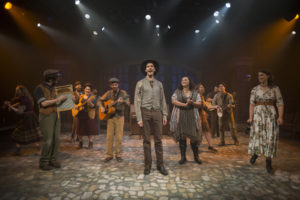
Behind the set, music director Robert Ollis is seemingly playing a full brass quartet. On his music stand, the score is open to a song entitled “Workingmen, To Arms!” and the keyboard is set to the French Horn sound.
“98% of the music in the show is acoustic,” he explains, referring to the string instruments played by every member of the cast. “For special effects, we have the keyboard. In the circus scene, no one could play tuba. So an actor plays tuba here.”
The lights in the space begin to flicker rapidly as Mazzocca begins a spot check, testing every light in the grid. During this maelstrom of flashes, the first actor crosses through the space––Amanda Giles, who plays Nina Van Zandt. She tosses a brief hello to the production team as she exits backstage right, where a staircase will lead her to the Den’s rickety basement.
1:25 PM
The underground dressing room includes a platform about four feet high, which serves as a receptacle for all of the men’s personal items needed for the show. As for bags, they’ve found a home on a stacked pile of chairs in the corner of the room.
“Are we still on the ‘putting all our stuff on this stack of chairs’ business?” asks Kelan M. Smith.
“I guess,” Mike Mazzocca replies. Both are performers in Haymarket, early to call.
Glancing around the room, Smith notices something new on the table.
“What is that?” he asks, point to the red sphere sitting in the center of the table.
“It’s for Nick,” Mike explains, holding it out. “It’s a bomb.”
“Perfect.”
“It’s basically a giant firework.” A seemingly ideal gift for a musical about anarchy and a historic Chicago bombing. “We’ll all sign it and give it to him tomorrow.”
By this time, Smith has hung a guitar around his shoulder, and begins idly strumming one of the tunes from the show. This gives Haymarket its distinctive atmosphere––a cast of actor-musicians means that, at any given time, it’s more likely than not that someone is plucking away at the strings of whatever instrument they have on their person.
Another actor, Joey Harbert, enters and strikes right into a stinging rebuke of the 93° blaze on Milwaukee Avenue: a power surge in his apartment left him unable to dry his hair properly, leading to the shaggy man-bun that he is now sporting––and will have to wear for the show.
Kristin Mazzocca’s voice calls out from the other room: “If you are down here, you shouldn’t be!” Elleon Dobias, standing in front of a mirror, immediately drops her makeup, takes up her violin, and heads for the staircase.
1:30 PM
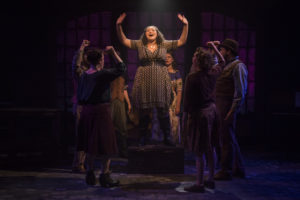
On the platform upstage, Assistant Stage Manager Christine Lauer is twisting a red banner into a tight roll, preparing to stick it into one of the dropboxes above the stage. Both she and Mazzocca stand out in stark contrast to the cast––their modern all-black clothes a vast departure from the tan and grey 1880s wear of the musicians, now listening intently to Thornton.
Thornton instructs the company to run through the show’s finale, to practice the transition into the curtain call––during which most of them will still be playing music.
“Okay, and ‘Leading the ma-a-a-arch!’ Rapturous applause!” Thornton calls out.
On cue, the actors begin playing the bows music, turning first to the front bank of seats, then splitting to acknowledge the sides of the thrust. This done, they conglomerate around the piano. Melanie Vitaterna stands on the piano bench, careful not to fall onto Erik Pearson as he plays.
“Thank you all for coming!” she ad libs. “Something, donate, Underscore is awesome!”
An initial attempt to shift from a vamp to the song’s chorus falters, leading bassist Eric Loughlin to clarify the beats.
“Let me just go, ‘one, two, one two hear the…’” indicating how Dobias’ pickup notes will precede the transition. With another run, the music slides into place.
Up next to run through: a scene where six workers are shot. The trick here is a lighting cue.
“The lights will cut when you all fall,” Thornton explains. “Rather than fading during the slow-mo bit. So you will do what you’re doing, and then at the end when you all drop…”
He motioned to Kirstin, in the tech booth.
“Lights.”
Watched on by Ollis and assistant director Jena Sugai, the cast expertly executes the pantomimed gunshots, providing Mazzocca with the cue to drop the lights.
“Good, moving on,” Thornton says.
The last moment to be run as a full cast is “Letters To My Love,” a duet between Albert and Lucy Parsons. The cast provides a sonorous blanket of strings around the edges of the stage, while Bridget Adams-King and Eric Pearson take focus at center. As the actors work through the song, a man is using a headlamp to see while he sets up a complex network of mics around the theatre, connected to a pair of video cameras in the back row. The resulting footage will be used for marketing, and serve as Underscore’s archival recording of Haymarket.
The camera’s display frames the picture onstage: Smith, Vitaterna, and Loughlin framed in silhouette against the back wall, as “Letters To My Love” reaches its final light cue.
2:04 PM
Back underground, the actors are finalizing their hair and makeup for the performance. Josiah Robinson has slipped into a green necktie and plaid vest, and has begun the process of combing gel into his hair.
Across the room, Giles is already in costume: a slender white baby-doll dress with a belt across the center, and a pattern of stemmed flowers around the fabric.
The final resident of the women’s area is Sarah Beth Tanner, making a fashion statement in her time-period shirt, time-period skirt, and monochromatic sneakers. She does vocal trills as she changes into footwear more befitting the time period.
Over the speakers, the strains of “Let Me Entertain You” from Gypsy can be heard. Mic checks have begun onstage.
As Dobias helps Tanner put her mic belt on, the latter indicates a bag on the table. “By the way,” Tanner says, “I have these if you’d like to borrow them.”
“Oh, definitely, thanks.” Dobias pulls out a handful of hair clips. “I’m just not good with hair. Bobby pins just fall out.”
Another actor––Vitaterna––appears, on a search for socks.
“These are your socks if your socks are seen––” Tanner explains, holding up a knit pair of colorful socks. “And if your socks are not seen, wear the grey ones.” She indicates Dobias, already wearing a pair.
Vitaterna seems to recall the costume designer putting her in grey socks. “But I’m not even wearing boots!” she cries out.
The colorful socks, she notices, match her entire outfit.
“You know,” she finally decides. “I think Mrs. Fischer is now a visual sock person, because I’ve found my soulmate.”
Vitaterna pulls off the grey socks.
2:33 PM
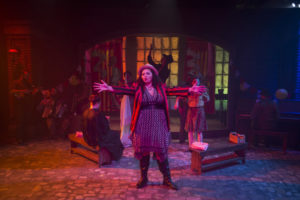
On the stage, Giles is completing her mic check. She paces the front of the stage, singing while keeping an eye on the tech booth for the approval of Deon Custard, the production’s Sound Engineer. During the performance, he will sit with Mazzocca in the tech booth and nimbly balance each actor and instrument in real time.
At Custard’s indication, Giles trails off in her singing, walking upstage to a huddle formed by Thornton, Sugai, and Harbert. The trio are discussing Thornton’s tendency to refer to actors by their physical traits when stressed: “the one with the beard,” or “that guy in the hat.”
“What would you call me?” Giles inquires.
“The Tall Shapely Woman,” Thornton replies.
As the mic checks continue, David Kornfeld––the other writer of Haymarket––sits with Higgen-Houser in the house, discussing final edits for the show. The musical, which began at Underscore in 2016 before being revised and restaged this year, represents a significant investment of time and effort for the two men, and for Underscore as a company. The two watch, rapt, as the actors cycle through the stage.
As the final actor departs mic check, TJ Anderson arrives onstage again, trumpet in hand. The evening’s only brass instrument, the horn’s peal reverberates through the theatre in a way not heard up to this point. It, and the ever-growing cloud of haze from the upstage foggers, have filled the empty theatre by the time Mazzocca crosses the stage.
“Ten minutes to places!” she shouts as she crosses. By this point, the ladders, cables, paint cans and backpacks that only minutes ago filled the house have vanished from view.
From offstage right, a voice: “Let’s run it quickly, before we open house.”
The voice belongs to Tanner, who has returned to the stage with Vitaterna. Squaring off on opposite sides of the stage, they begin pacing the floor while singing an incantative melody. “Blame is a fire, don’t fan the flame…”
Glancing down, Tanner notices something in Vitaterna’s pace––a variance in footwork as the two cross the stage.
“How are you––” she asks, indicating the footwork.
As Vitaterna demonstrates the turns again, Tanner watches.
“Here, this is what I did last night,” she says, showcasing the placement of the feet. Pivoting on the ball rather than the heel, keeping the upper body flat. “Does that work?”
“Sure, sure.”
2:50 PM
“Come on in, be careful!”
A hallway separates the leftmost bank of seats from the edge of the Heath Mainstage wall, but this is not where the usher leads the expectant audience. Instead, they snake around the side of the risers, depositing the audience far stage left and leaving them to cross the stage to find seats. Most settle into the center section, but the adventurous types venture to the edges of the thrust. The programs they hold are made to look like newspapers––appropriate for a musical where the press is such an integral part of the plot––with a production photo of Bridget holding a guitar on the front.
The program, as is so often the case in a storefront, is also their ticket.
As the murmur of the audience grows, Tanner stands alone backstage with a guitar. In the dark of the wings, lit only by the dim glow of a down-facing light, she sways lightly back and forth, tuning the guitar again. At her feet are three more instruments, leaning against the wall in preparation of being picked up by the actors.
It’s a quiet moment in a tumultuous process. With all the tasks in progress before the first preview of Haymarket can begin, the corner is a secluded place where an actor can mentally prepare to embody another person for two and a half hours.
She exhales.
At a distance, the sound of footsteps can be heard, rounding the corner before starting up the creaking stairs. At once, Dobias appears, whipping around the corner and placing a hand at the edge of the prop table.
“What’s up?” Tanner asks, as Dobias scans the table.
“We’re missing a drum brush.”
3:04 PM
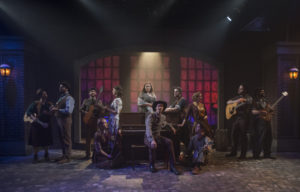
Places having been called, the actors crouched just offstage when Mazzocca texts Lauer to send the actors out for preshow. Preshow––typically, as it suggests, before the show begins––has been pushed back with the rest of the times tonight due to tech delays. But finally, Smith is out onstage, shuffling about and picking out guitar notes. The audience slowly but surely notices, but continues conversing with each other.
Smith is quickly joined by other members of the cast––Loughlin, Harbert, Tanner, Vitaterna.
The crowd has mostly fallen silent when Loughlin steps into the spotlight and formally welcomes the audience. “There will be loud noises, there will be lots of fog, there will be lots of leftist politics,” he warns, garnering a chuckle from the knowing crowd.
As Loughlin steps away, Pearson, seated at the piano bench, strikes the tuning chord for the instruments. Everyone settled, the collected cast waits only a moment before inhaling together and launching into Haymarket’s opening number.
3:22 PM
To watch Mazzocca call the show is to watch an archer eyeing a row of targets. Her hand constantly hovers over the button labeled “GO” on the light board, her ears cocked for each cue line as the musical rumbles along. When they reach the scene where six people were shot, she stands, ducking her head beneath the low ceiling of the booth, watching as Loughlin takes aim at the crowd.
*click*
“Damn,” she mutters. Called too early.
She scribbles down the note on her run-sheet––a list of everything she will do during a performance.
Returning to the show, she focuses on the actors, her eyes tracing each movement to ensure that blocking and choreography is retained as Thornton set it weeks ago. During the upbeat dance numbers, Mazzocca dances along––as much as she can do while sitting down.
Everyone is feeling fairly relaxed when the song “Lady Dynamite” rolls around. Sung by Harbert, this is Louis Lingg’s love waltz to his anarchist sweetheart, as well as a metaphor for Lucy Parson’s flirtation with violence. Joey cues the ensemble to play, and sings as he and Adams-King twirl around the stage.
“Dance with me, Lady Dynamite,” he sings. But then falls silent. The music plays on, and Harbert twirls Adams-King around, but up in the booth, Mazzocca’s eyes are wide open.
“Oh no.”
Harbert is still fumbling for words. Mazzocca watches the display from between her fingers, while Custard attempts to stay the course.
“You’re my…and you…” Harbert flails through phrases, searching for the correct verse, before triumphantly getting back on track. The shoulders of the cast collectively lower several inches as the tension seeps away.
Meanwhile, Mazzocca is adjusting the schedule in her head. A flubbed “Lady Dynamite” means the number will need to be filmed again, or else never used in marketing. This will have to happen after the performance, before the actors leave for the night. That means getting out closer to 6:30 PM, rather than 6 PM. But it’s doable.
All this is written down on the runsheet, below the scribbled “CALL WHEN ACTORS HIT FLOOR.”
4:02 PM
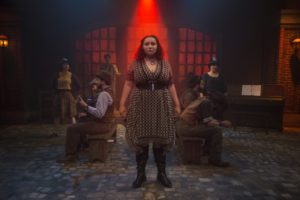
*click*
The lights rise over the audience. Intermission.
Custard bolts back down a stairwell towards the dressing rooms, where he takes up residence at his table of mics.
At one end of the women’s table, Adams-King and Tanner are talking when Giles walks into the room.
“Is there something planned for tomorrow?” Giles asks. “After the show?”
“Standard’s Bar, across the street,” Tanner replies.
“Great.” Giles sits, but Adams-King is still looking at her flowery dress.
“I ordered a couple of nice dresses on Amazon for tomorrow,” Adams-King stated. “Because they have that free return policy?”
“Right.”
“I’m pretty sure I saw your dress there.”
Giles fans out the skirt of the dress, showcasing it. “That’s amazing. Yeah, I think she just got this on Amazon.”
All conversation stops as Thornton enters the room. The cast immediately fall into peals of congratulations, and a few pointed questions about how the show looked.
“It’s going great, everyone,” Thornton answers. “Though we have a few announcements. First, when we get to ‘Keep On Talking, August Spies,’ just stay facing upstage. I don’t know why I made it complicated. Just face upstage.”
A few people nod.
“And also, after the show, we are going to run ‘Lady Dynamite’ again, so we have a filmed version.”
The cast agrees. Harbert’s head droops slightly.
“No trouble, we’re all nervous. Is that going to work?”
It would, the cast indicates.
“Okay. Nice work, everyone!”
As Thornton leaves, Tanner returns to the mirror to adjust her hair. She takes another handful from the open Trail Mix on the counter. Dobias, for her part, has an open Ziploc of apple slices––which Vitaterna notices from afar.
“Elleon, could I trouble you for an apple slice?”
“Sure.
Tanner watches in the mirror as Dobias tosses the bag across the room––over her head, and into Vitaterna’s hands. “Nice catch, gang.”
“Thanks, we do sports,” Vitaterna replies, flexing.
4:23 PM
The first song of Haymarket’s second act––after the entr’acte, performed by Pearson for solo piano––is the slow-burn chant called “Blame.” Downstage, Vitaterna and Tanner make eye contact with each other as they nail their new pivot-turns. “Blame is a fire, don’t fan the flame…”
Backstage, Pearson makes a pit stop behind the set to grab a drink of water before “Letters To My Love.” The water bottle placed carefully behind the wall so as to not fall over, he heads back out with a stack of envelopes. No longer saving her vocals, Adams-King soars through the ballad, enrapturing the audience with her powerful cry for her husband to return home.
Giles––who does not participate in the song––sits alone backstage. On the lip of the back platform, she takes a well-deserved rest as the two lovers sing onstage. Four feet away, Smith is in audience view, playing the backing melody on his guitar.
During the slower moments of the second act, some of the actors have these kinds of breaks backstage, a way of conserving energy for the play’s physically and emotionally difficult moments. Both Vitaterna and Tanner have a moment to breath offstage right before entering wearing a police helmet and judge’s robe, which begins the play’s most active scene.
“It was a goddamn circus!” Adams-King yells.
Lauer pulls a chord backstage and the two banners fall open from their dropboxes. Harbert runs backstage, and sits at the keyboard. As Anderson’s trumpet blares out a playful melody, Harbert accompanies him on keyboard with a delightful walking tuba line.
And from the box at the back of the set, four red clown noses emerge. None fall off. Not a single one is edible.
5:17 PM
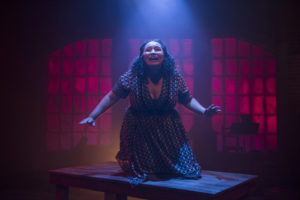
As the applause builds, the piano at stage right is pushed back to the center of the stage, where it began. The actors, following what was rehearsed not four hours ago, circle around the piano. Before Vitaterna can even begin her final speech, the crowd has risen to their feet, cheering wildly.
“Thank you so much!” she begins. “I’m so glad you were our audience!”
Standard statements are spoken regarding the importance of donations and word of mouth. One of the actors places an empty guitar case out at the front edge of the stage, the panhandling cast making the request for donations much clearer.
The music finishes, and the cast make a beeline for the stage left exit––the only one that leads downstairs. It’s during this moment that someone’s voice rises up, loud enough to be heard by the actors but not the cheering crowd.
“Remember to stay in costume!” it calls. “We’re running ‘Lady Dynamite’ after this!”
The guitar case slowly but surely begins to fill with cash as the crowd passes by.
Soon, everyone remaining in the theater is a face recognizable from earlier in the afternoon, when the front row was still filled with cables. The actors meander out to the house, discussing the performance. Some of the issues raised are ones that no audience member noticed––a misplaced guitar during “Letters,” clown noses left in places that they shouldn’t have been.
In all the rush, no one notices Laura Stratford, Co-Artistic Director of Underscore, who has appeared at the front of the stage. She pulls the wad of bills out of the guitar case, and quickly counts them.
“Twenty-two dollars,” she states. “I’ll take it. Literally.”
5:31 PM
“…7, 8, 9, 10…” Thornton mutters, counting the people onstage.
The last few stragglers finally appear, and the cast fall into seats on the right side of the audience as Mazzocca and Lauer continue to reset the space for “Lady Dynamite.”
“Hey everyone!” Thornton says to the assembled crowd. “How are we feeling?”
Tired is the implied response from the vocal groans.
“So,” Thornton begins. “We open tomorrow. Make sure you prepare for that, get the rest you need. Walk through the script and think through the whole show for yourself. Entrances, exits, prop movement. There was a guitar that was missing today…”
The actors begin a collective explanation of the prop’s disappearance before Thornton waves them off.
“Look over everything,” he repeats. “The work never ends. You tell the story so beautifully, we want every audience to get that. Got it?”
Mazzocca steps forward. “Additionally, some of you have requested a digital copy of the script. That will be sent out tonight.”
“Thank you,” comes a voice from the back.
“Any questions?”
Tanner raises a hand. “I hear rumors of an aftersomething tomorrow night?”
At this, Stratford steps up. “Yes, there is a party tomorrow night at Standard’s Bar and Grill, immediately following the show.”
“Who’s invited?” Tanner asks. “Family? Friends? Significant others?”
“Errbody,” Statford smiles.
“All right, let’s run this number and go home,” Thornton says, walking off the stage.
“Places for ‘Lady Dynamite!’” Mazzocca calls.
Focused, the actors shift back into their places. Soon, the stage is a carbon copy of the scene from earlier in the evening––costumes, lighting, props all perfectly returned to their settings.
Harbert, not indicating a hint of nervousness in his voice, kicks off the song as he normally did. When he reaches the chorus, everything seems just as it was before, except for the adamant and clear diction with which he states every lyric, not missing one.
5:45 PM
Lauer flutters around in the dark behind the proscenium, a light hanging around her neck helping her to catch every prop as she painstakingly returns everything back to the way the night kicked off. The platform is suddenly awash with instrument cases and crates, all moved out of the wings for ease of movement––and to assure they don’t block Lauer’s view of any props.
A suitcase, containing all the props for the circus, is beginning to fill again. With a fistfull of red clown noses, she counts as each one is placed into the special pocket on the side of the case (ensuring none get lost among the ruffs, coats, and other accoutrements).
“Stage management!” calls Thornton. “Production meeting!”
Lauer joins Mazzocca in the circle of designers downstage, who are now playfully talking with the writers about which numbers they’d be smart to cut out of the show before it’s formal opening tomorrow.
“I think you should replace all the actors with puppets,” Sugai suggests.
The meeting is occasionally interrupted by the crossing of actors through the space, headed for the doors of the theater. There’s much to discuss––not only with opening night imminent, but with the designers about to move onto other projects. Mazzocca and Lauer are given plenty of information on how to keep the show looking good through closing night.
The longest discussion in the meeting concerns how the audience enters the space.
“Today, the Saints led people through the area between the seats and the edge of the stage––”
“Yeah, they shouldn’t do that.”
The reason comes out that a spare cable, strung across the area where the audience should have entered, has made the area a trip hazard. “Can we just put a rug over it?” suggests the lighting designer.
The group agrees to consider it. Meanwhile, the Saints will now be instructed to lead people away from the gap between the seats and the stage.
“Could we put something there, to guarantee people don’t walk through? A chair, or…”
“We could put the donation box there.”
“Oh, great, that’ll guarantee no one goes there.”
6:32 PM
Up in the booth, the lighting designer is showing Mazzocca one more feature of the light board.
“If you ever come in here and it doesn’t say ‘Haymarket’ on the screen, just open the file here.” He clicks around on the monitor, and suddenly the file containing the production’s light cues pops up on the screen. “That’s your backup. Any other problems, contact me.”
“Got it.”
Mazzocca kills the stage lights, returning the room to a general wash of work lamps that give the room a dim, ochre glow, and heads back to the stage.
“See y’all tomorrow!” calls a voice, already halfway out the door.
“Go home,” Mazzocca says to Lauer, who stands texting at the stage’s edge.
“See you tomorrow,” Lauer calls as she shoulders her bag.
“You da best!” Mazzocca shouts as her partner leaves the space.
Alone for the first time since 1 PM, Mazzocca finishes rolling up the banner and returns it to its spot backstage. The space looks much like it did five and a half hours ago––save for the absence of the ladders on stage.
Looking out over all this, Mazzocca takes up her own bag. Keys in hand, she shuts off the lights by the front door, and locks the unassuming door to the Heath Mainstage.
“There might be some designers who will come in to do work tonight, but they have a key,” she assures. Tucking the keys back into her bag, Mazzocca finally exits the space, crossing out the glass doors of the Den Theatre and onto Milwaukee Avenue.
In just under 24 hours, the opening night performance of Haymarket will begin.
Haymarket performs until July 22 at The Den Theatre, 1331 North Milwaukee Avenue. Tickets are available at the Den Theatre website, or by calling (773) 697-3830. More information about the show, and Underscore Theatre Company, can be found at underscoretheatre.org/haymarket.

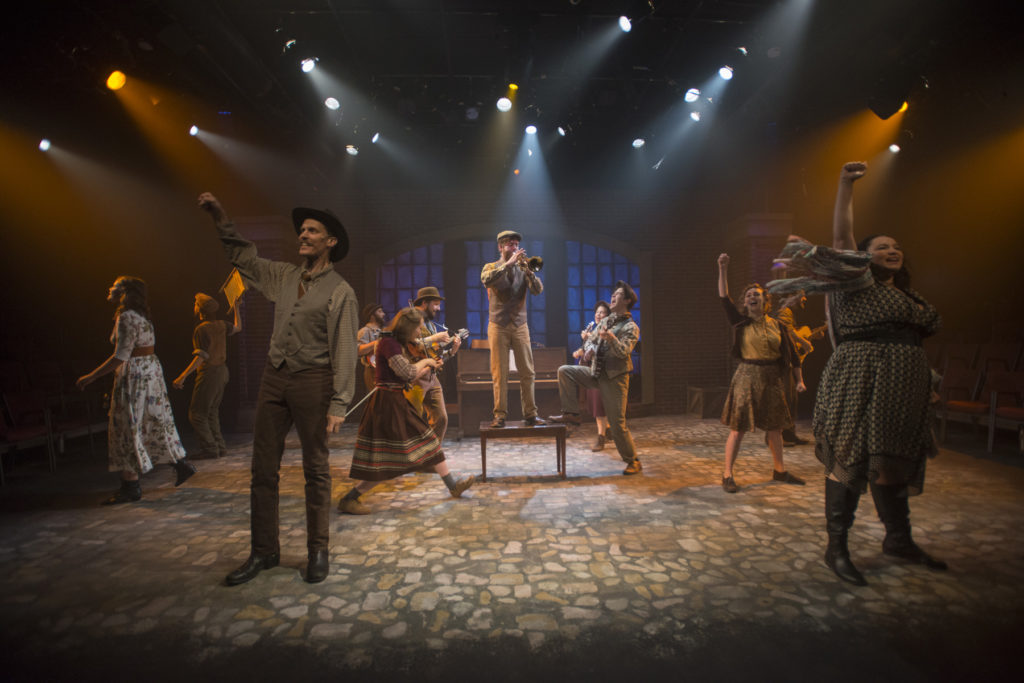

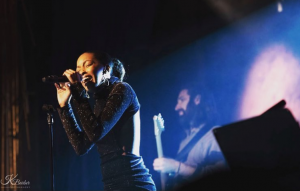
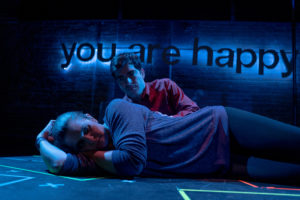

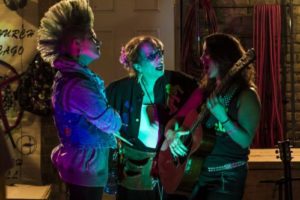
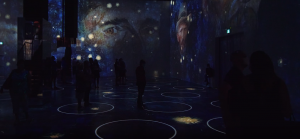

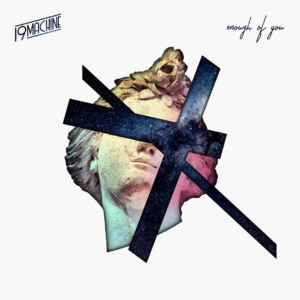

Be First to Comment